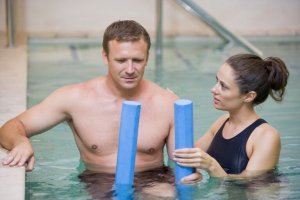Advantages and Disadvantages of Aquatic Therapy

You can do more than just swim in a pool or the ocean. In the water, there are certain experiences that you can’t enjoy on dry land. Therefore, taking advantage of them can help rehabilitate certain conditions. Here, we’ll talk about the advantages and disadvantages of aquatic therapy.
Characteristics of the aquatic environment
Aquatic therapy is when you use water for therapeutic purposes. Although we might not know all of the benefits it offers us, it has some great advantages over dry land treatments. Some of them are:
- Reduction of body weight. As we’ve all experienced, when you dive into water, you feel lighter. This is because water exerts an upwards force on your body. Then, this force takes pressure off of your joints.
- Relaxation. Water, especially at a comfortable temperature, helps vasodilation and circulation. In addition, by supporting your body, it relaxes the muscles that usually maintain your posture.
- Movement resistance. Water has a resistance to movement that’s much greater than air. Also, this resistance can be significantly increased with the help of some external elements.
Advantages and disadvantages of aquatic therapy
Advantages
Due to the factors we already mentioned, aquatic therapy is beneficial for treating different conditions. First, since it reduces your body weight, it’s a great way to start rehabilitation after trauma.
When a pathology affects our joints, being able to work in the water is best. In fact, it reduces the pressure on the joints. That way, you can start to build mobility after a hip surgery or a knee problem.

Also, it’ll help the patients who’re afraid to move a joint after a surgery.
In addition, water is a great ally to strengthen muscles because of its resistance. You can start gaining strength without putting your joints at risk. You can regulate the difficulty of the exercises in the water, too.
On the other hand, it also allows you to balance and be aware of your body’s movements because water is unstable. The movement of the water will make you constantly correct your posture. Also, it’s easy to make an exercise more difficult. For example, you could try standing on one leg, closing your eyes, walking on the balls of your feet or playing catch.
As for relaxation, this will be key to treating conditions that cause muscle spasms. Therefore, it’s helpful to mobilize the limbs of people with spinal cord injuries or cerebral palsy.
Disadvantages
The only drawbacks are situations with patients that have infections, skin diseases or circulatory failure.
However, you should also keep in mind that pressure on your joints is necessary for proprioception and healthy bone formation. Also, it helps with normal joint function and good body posture.
Therefore, aquatic therapy will be beneficial in initial stages of recovery from a traumatic injury, but you’ll gradually need to move to dry land.

Aquatic therapy: a complex world
There are lots of aspects and possibilities in the world of aquatic therapy. In this article, we’ve addressed the treatment with the body fully immersed in warm water.
However, there are differences between using cold, warm or hot water, fresh or salt water, being submerged or applying a jet on a certain part of the body. There are different types of showers and even substances that you can add to water to obtain certain effects.
Finally, there are also spas that try to offer many of these benefits for patients that just want to relax and improve circulation. Water really is a complex world, but we can use it for our health, without a doubt.
You can do more than just swim in a pool or the ocean. In the water, there are certain experiences that you can’t enjoy on dry land. Therefore, taking advantage of them can help rehabilitate certain conditions. Here, we’ll talk about the advantages and disadvantages of aquatic therapy.
Characteristics of the aquatic environment
Aquatic therapy is when you use water for therapeutic purposes. Although we might not know all of the benefits it offers us, it has some great advantages over dry land treatments. Some of them are:
- Reduction of body weight. As we’ve all experienced, when you dive into water, you feel lighter. This is because water exerts an upwards force on your body. Then, this force takes pressure off of your joints.
- Relaxation. Water, especially at a comfortable temperature, helps vasodilation and circulation. In addition, by supporting your body, it relaxes the muscles that usually maintain your posture.
- Movement resistance. Water has a resistance to movement that’s much greater than air. Also, this resistance can be significantly increased with the help of some external elements.
Advantages and disadvantages of aquatic therapy
Advantages
Due to the factors we already mentioned, aquatic therapy is beneficial for treating different conditions. First, since it reduces your body weight, it’s a great way to start rehabilitation after trauma.
When a pathology affects our joints, being able to work in the water is best. In fact, it reduces the pressure on the joints. That way, you can start to build mobility after a hip surgery or a knee problem.

Also, it’ll help the patients who’re afraid to move a joint after a surgery.
In addition, water is a great ally to strengthen muscles because of its resistance. You can start gaining strength without putting your joints at risk. You can regulate the difficulty of the exercises in the water, too.
On the other hand, it also allows you to balance and be aware of your body’s movements because water is unstable. The movement of the water will make you constantly correct your posture. Also, it’s easy to make an exercise more difficult. For example, you could try standing on one leg, closing your eyes, walking on the balls of your feet or playing catch.
As for relaxation, this will be key to treating conditions that cause muscle spasms. Therefore, it’s helpful to mobilize the limbs of people with spinal cord injuries or cerebral palsy.
Disadvantages
The only drawbacks are situations with patients that have infections, skin diseases or circulatory failure.
However, you should also keep in mind that pressure on your joints is necessary for proprioception and healthy bone formation. Also, it helps with normal joint function and good body posture.
Therefore, aquatic therapy will be beneficial in initial stages of recovery from a traumatic injury, but you’ll gradually need to move to dry land.

Aquatic therapy: a complex world
There are lots of aspects and possibilities in the world of aquatic therapy. In this article, we’ve addressed the treatment with the body fully immersed in warm water.
However, there are differences between using cold, warm or hot water, fresh or salt water, being submerged or applying a jet on a certain part of the body. There are different types of showers and even substances that you can add to water to obtain certain effects.
Finally, there are also spas that try to offer many of these benefits for patients that just want to relax and improve circulation. Water really is a complex world, but we can use it for our health, without a doubt.
All cited sources were thoroughly reviewed by our team to ensure their quality, reliability, currency, and validity. The bibliography of this article was considered reliable and of academic or scientific accuracy.
- Ibarra Cornejo J.L., Quidequeo Reffers D.G., Eugenin Vergara D.A., Beltrán Maldonado E.A., Ricci Muñoz S.R., Fernández Lara M.J.. Efectividad de la hidroterapia para disminuir el dolor y mejorar la calidad de vida y función física en adultos con osteoartritis de rodilla: revisión sistemática. Rev. Soc. Esp. Dolor [Internet]. 2015 Ago [citado 2019 Dic 11] ; 22( 4 ): 168-174.
- Pavez Ulloa F.J.. Agentes físicos superficiales y dolor: Análisis de su eficacia a la luz de la evidencia científica. Rev. Soc. Esp. Dolor [Internet]. 2009 Abr [citado 2019 Dic 11] ; 16( 3 ): 182-189.
- Cazorla González J. J., Cornellà i Canals J.. Las posibilidades de la fisioterapia en el tratamiento multidisciplinar del autismo. Rev Pediatr Aten Primaria [Internet]. 2014 Mar [citado 2019 Dic 11] ; 16( 61 ): e37-e46.
This text is provided for informational purposes only and does not replace consultation with a professional. If in doubt, consult your specialist.








